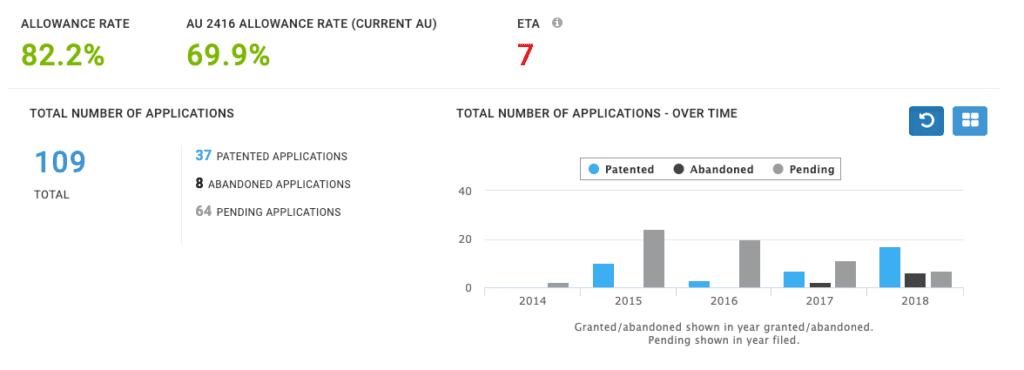3 Reasons PatentAdvisor Examiner ETA™ Is Better Than Allowance Rate

It was not that long ago that patent analytics changed the way patent professionals approach patent prosecution. The ability to access key USPTO examiner statistics has enabled professionals to adapt their prosecution strategies to their assigned examiner for improved outcomes. With time, however, comes new insights that lead to greater improvement – and patent analytics is no exception. Commonly used USPTO statistics, such as an examiner’s allowance rate, will always have their place in the patent process to help understand a patent examiner’s history. That being said, patent statistics alone rarely tell the entire story, and the circumstances surrounding an examiner’s statistics should also be considered before drawing conclusions about the examiner’s future behavior. LexisNexis PatentAdvisor® introduced the idea of examiner allowance rate and has improved upon that metric to now offer PatentAdvisor ETA™, a patent metric produced from a proprietary algorithm that factors in the big picture. PatentAdvisor ETA is a more accurate and more predictive indicator of examiner behavior than an examiner’s allowance rate, and here are three reasons why:
Reason #1: PatentAdvisor ETA takes into account all pending applications (not just patented and abandoned applications)
What does a patent examiner’s allowance rate really tell us? Allowance rates are calculated by simply dividing the number of patents an examiner has granted by the sum of the patented and abandoned applications he or she has reviewed. On its face, an allowance rate is a great way to gain an understanding of whether a patent examiner has been more or less likely to grant a patent in the past. The biggest drawback in relying on an allowance rate to predict an examiner’s future behavior is that all of the pending applications an examiner is working on go unaccounted for.
Taking a look at the USPTO examiner information presented below, one might quickly conclude that an application reviewed by this examiner has an 82.2 percent chance of being patented based on the allowance rate shown. When we look more closely, we see that the allowance rate has been calculated based on only 45 total patent applications (37 patented applications and 8 abandoned patent applications). The majority of the examiner’s total cases (64 patent applications) remain pending, and the final disposition of those pending applications may greatly impact the examiner’s future allowance rate. Because this patent examiner’s allowance rate is based on a relatively small number of patent applications, this examiner has been assigned a high value examiner ETA of 7, which means the likelihood of a long and bumpy prosecution is very high.
This example clearly illustrates the volatility in relying on the examiner’s allowance rate to predict future actions and to decide the prosecution strategy. The deceivingly high allowance rate of 82.2% would lead you to believe you will have a relatively easy prosecution path, when the reality is that the prosecution path for an examiner ETA over 6 is likely to be long and expensive.

Reason #2: PatentAdvisor ETA factors in each examiner’s USPTO experience
People change over time. They learn and they grow, they make fewer mistakes, and they gain confidence in their decisions. Patent examiners are no different, and they also develop their skills and opinions throughout their experience at the USPTO. As a result, relying on an allowance rate could lead to an inaccurate bias against, or in favor of, a particular patent examiner based on their past decisions. For example, a patent examiner who was historically difficult to deal with but who has recently become more applicant-friendly will be viewed through the lens of his allowance rate as being a difficult examiner. PatentAdvisor ETA seeks to eliminate the bias inherent in allowance rates by taking into consideration each examiner’s experience and decision trends to produce a more predictive patent metric.
Reason #3: PatentAdvisor ETA is driven by an examiner’s behaviors, and not by a filer’s actions
There are two major players in the game of patent prosecution – the patent applicant and the patent examiner. Both individuals have the ability to impact the final disposition of a patent application, and an abandoned patent application is not always attributable to the patent examiner. An allowance rate does not discriminate between those applications that went abandoned because of an insurmountable rejection from the patent examiner and those that went abandoned because of applicant’s actions, such as failing to reply to an office action in a timely matter or deciding to willingly abandon due to a low business value of the patent. This distinction is important for accurately evaluating a patent examiner’s difficulty and the ETA algorithm does not fault patent examiners for actions taken (or not taken) by a filer.
For the most reliable and accurate predictor of patent examiner behavior, patent professionals rely on PatentAdvisor ETA. It is just one of the many exclusive metrics and features available within LexisNexis PatentAdvisor®. Patent professionals rely on the industry’s best patent analytics found in PatentAdvisor®.
Access examiner analytics from the USPTO PAIR and Patent Center websites.
Learn more by reading Patent Prosecution Analytics: No Longer Just a Nice to Have and watching the on-demand webinar.
Learn more about PatentAdvisor and PatentAdvisor ETA.
